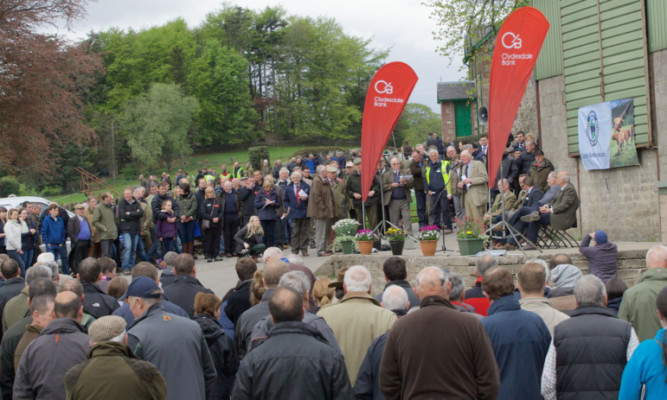A few buzz words dominated Scotland’s Beef Event at Mains of Mause.
Given the recent prominence of CAP changes it might have been thought that support changes would be among them but they were barely mentioned.
Instead the talk was all of quality, consistency and collaboration. Without these it would seem the beef industry will not fulfil its potential.
Ian Galloway, chairman of Scotbeef at Bridge of Allan, set the tone when he officially opened the event.
Praising host farmers Peter, Pat and Murray Alexander for the quality of their stock, he used them as an example of what could be achieved.
Scotbeef has records for 110,000 cattle each year going back five years and the Alexanders’ consignments to Bridge of Allan, all Limousins, have killed out at a near optimum 340 kgs deadweight and have finished a remarkable 172 days earlier than the average.
The difference between finishing spring-born calves at 19 months of age compared to 24 months is significant for Mr Galloway’s business because it means cattle are available in October, November and December which is exactly when they are needed.
Of the home trade Mr Galloway said: “There are problems and challenges just now in what is quite a long production chain but we all need to pull together.
“Meat is a key product in every supermarket and we need quality and consistency to satisfy requirements.
“We are still getting too many heavy cattle consigned because farmers are keeping them too long to try and recoup the purchase price.
“Our figures, however, show that 0 grades (poorer carcases) are taking 48 days longer to finish and weigh 30kgs less. The proportion of U and R grades (better carcases) is increasing but there are still too many 0 grades.”
He added: “The message is to feed cattle quicker and get them away earlier.
“Also the suckler cow maybe needs to improve. There are very good bulls available now but the cow side of the equation probably needs more attention.”
Mr Galloway also used his speech to announce that the promised new Scotbeef abattoir at Thainstone near Inverurie is to go ahead with construction work beginning in October.
This will replace the Scotch Premier and Mathers of Inverurie sites which were purchased simultaneously by Scotbeef two years ago.
“The new abattoir will be to the same design as Bridge of Allan,” he said.
“It won’t be quite as big but it will have scope to expand.
“We need to make this investment to make our operations more efficient.
“Health inspections are also becoming ever more stringent.
“Yesterday we had American inspectors at our Queenslie premises and if we are to have a trade with the US it means complying with another set of rules.”
Exports to the US were not imminent, but it was important to be ready.
Keeping existing export markets open was important but difficult at the moment with currency exchange rates as they are.
The pound-to-euro exchange rate had added 22 pence per kg on to export beef compared to a year ago taking the competitive edge off Scotch Beef.
Customers had to be kept on board, however, even if this meant at the moment sending trucks to the continent only two thirds full.
“The market will come right again though and we could do with another 150 farms in Scotland producing to the standard we have seen today,” Mr Galloway concluded.
Innovation
The British Limousin Cattle Society is using a combination of new technologies to try to better match customer demand with the cattle being produced.
Society chief executive Iain Kerr said: “This is a four-year £1.2m project involving ourselves, Anglo Beef Processors (ABP) and SRUC (Scotland’s Rural College).
“It uses genomics to identify seven different carcase traits including, for example, the proportions of rump and topside which would be produced by using particular sires.”
Project leader Alison Glasgow said she is working alongside meat processor ABP in Perth.
The plant is the first in Scotland to use Video Imaging Analysis (Via) to scan carcases.
By comparing the scans with DNA taken from the cattle Dr Glasgow can compile a database which will help advise breeders when selecting sires.
“When the project is finished we should have enough information to predict beef efficiency traits,” she said.
